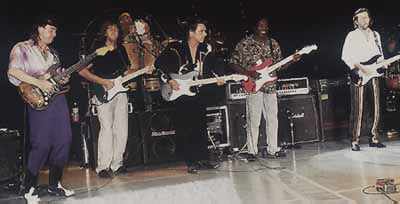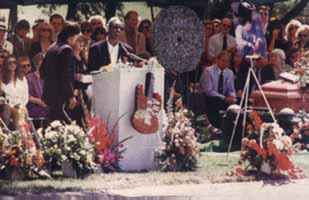Life without you (ra-file, 1,8 meg) |
 |
Monday, August 27, 1990 - Austin |
 The last performance |
| Four Bell 260B Jet Ranger helicopters awaited the artists and their respective entourages following the jam. Because of the logistical traffic nightmare at Alpine Valley - only one two-lane road leads from the venue, resulting in gridlock delays of an hour or more - the major acts usually depart via helicopter. The caravan of blues stars left Alpine Valley at two minute intervals. The first, second and fourth copters landed without incident at Chicago's Meigs Field. The third, bearing members of Clapton's entourage and Stevie Ray, never made it. Poor visibility due to dense fog is prominent among factors blamed for the disaster. (The Austin American Statesman later reported that, according to Federal Aviation Administration records. the copter's pilot, Jeffrey William Brown, had two previous helicopter accidents). |
By noon, a shock wave reverberates through the capital city of Texas.
It's the most devastating news to hit the Lone Star State's music community
since Buddy Holly, along with Richie Valens and the Big Bopper, went down in a
plane 31 years ago. People walk about tearfully, dazed and disoriented. Friends
call friends who call friends. |
| Fans begin converging on Zilker Park, where mourners gathered for a
candlelight vigil on the night John Lennon was murdered. Now, ten years later,
they sit side by side in the darkness, with 3.000 points of light flickering in
a sea of sorrow. Tatooed Chicago bikers sit next to lawyers in Brooks Brothers
suits, who sit next to New Agers who spread crystals on blankets and meditate
in silence. Fans clutching pictures of SRV construct shrines to the fallen
guitar hero. Young gunslingers tote their Strats, Buddhists chant
nom-yo-renge-kyo and old friends weep openly as dj Jody Denberg of Austin's
KLBJ pumps a steady diet of SRV through a makeshift PA out to the crowd. The
sound of Stevie Ray's stinging Strat pierces the night air and goes directly to
the hearts of these huddled blues fans, offering some kind of solace in the
face of utter despair. |

Stevie Wonder sings at SRV's funeral |
Tuesday, August 28, 1990 - Austin |
Guitarist Van Wilks remembers SRV as someone who transcended the various
musical cliques around Austin. |
Wednesday, August 29, 1990 - Austin |
Thursday, August 30, 1990 - Dallas |

Friday, August 31, 1990 - Dallas |

First to emerge from the chapel is Stevie Wonder. The hushed crowd looks on as he is led to a sheltered reviewing stand by the graveside. The casket is placed in a white hearse, which slowly drives to the site, mourners following behind on foot. Jimmie and his mother, Martha, walk alongside the late guitarist's fiance, Janna Lapidus. Behind them, strolling with heads bowed, Chris Layton and Tommy Shannon, flanked by Kim Wilson. Behind them are Jeff Healey and his band, a tearful Charlie Sexton, Dr. John, ZZ Top's Billy Gibbons, Dusty Hill and Frank Beard, Mark Pollac of Charley's Guitars in Dallas and Colin James, Charlie Comer, Stevie Ray's personal friend and publicist for the past eight years. Buddy Guy, overcome with grief, slips out of the chapel into a nearby car. |
The Rev. Barry Bailey of the First United Methodist Church of Fort Worth
(Stevie Ray's AA sponsor) opens the service with some personal thoughts, his
rich voice booming out to the crowd through two huge stacks of speakers. |

Back at the hotel, hours after Stevie Ray has been delivered into the
everlasting arms of Mother Earth, I lie quietly on my bed, listening to a tape
of an interview I had with him for Guitar World back in 1988, some months after
his departure from the rehab center in Marietta, Georgia. His words still ring
in my ears: |

© 1997-2008 www.corax.com - All rights reserved